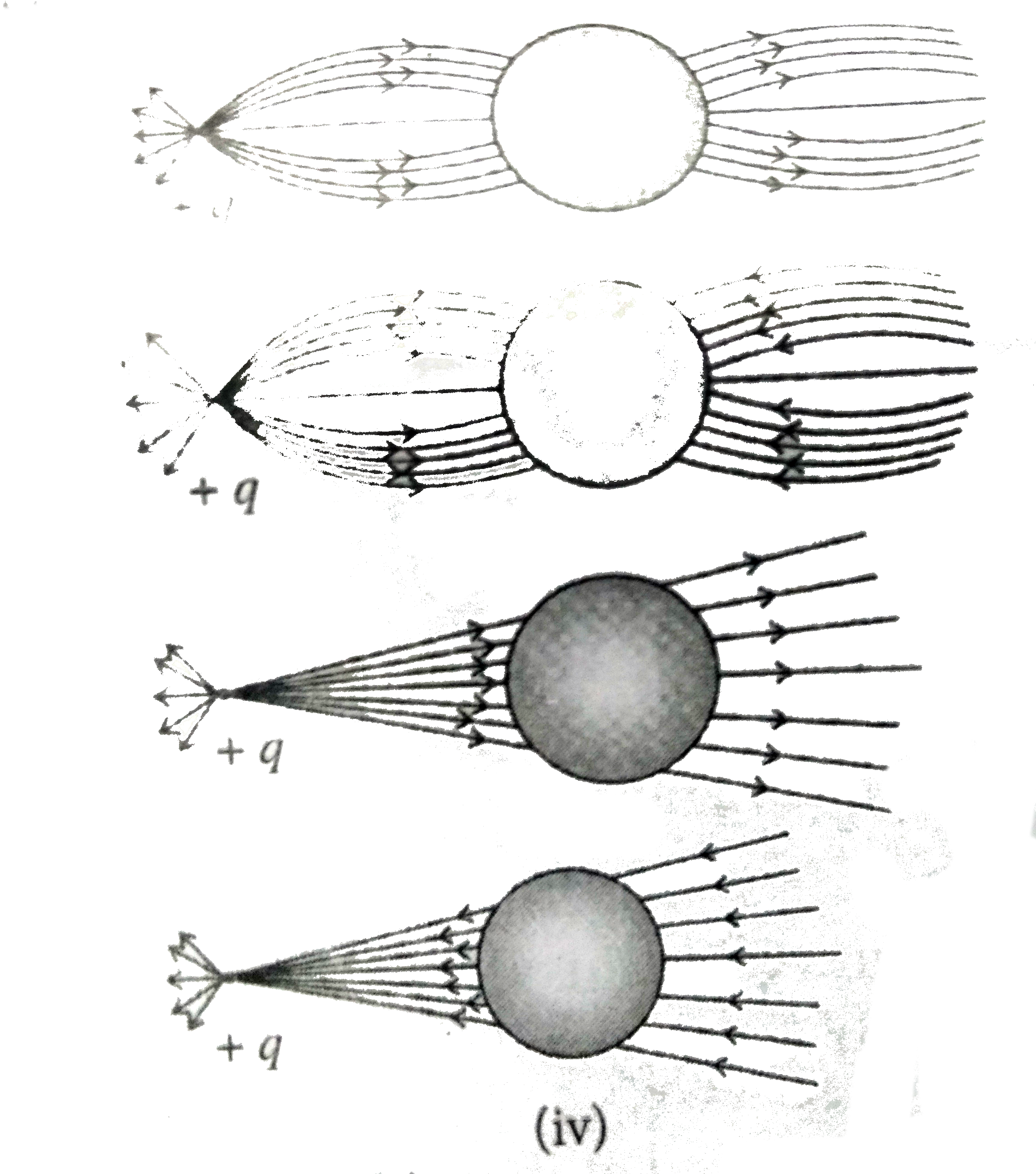A positive point charge Q is brought near an isolated metal cube then what will happen to the charge of cube?
The cube becomes negatively charged.
The cube becomes positively charged.
The interior becomes positively charged and the surface becomes negatively charged.
The interior remains charge free and the surface gets onouniform charge distribution.
The correct Answer is:D
To solve the problem of what happens to the charge of an isolated metal cube when a positive point charge Q is brought near it, we can follow these steps:
1. Understanding the System:
- We have an isolated metal cube, which is a conductor, and we are bringing a positive point charge Q close to it.
2. Effect of the Positive Charge:
- When the positive charge Q is brought near the metal cube, it creates an electric field around itself. This electric field influences the charges within the metal cube.
3. Induction of Charges:
- Due to the electric field from the positive charge Q, the free electrons in the metal cube will be attracted towards the side of the cube that is closest to the positive charge. This results in a negative charge accumulating on that side of the cube.
4. Distribution of Charges:
- As electrons move towards the side of the cube nearest to the positive charge, the opposite side of the cube will become positively charged due to the deficiency of electrons there. Thus, we have:
- Negative charge −Q on the side of the cube closest to the positive charge.
- Positive charge +Q on the opposite side of the cube.
5. Net Charge of the Cube:
- Despite the separation of charges within the cube, the total charge of the cube remains unchanged. Since the cube was initially neutral (isolated), the net charge of the cube remains zero. The positive and negative charges induced on the surfaces of the cube balance each other out.
6. Conclusion:
- Therefore, when a positive point charge Q is brought near an isolated metal cube, the cube will exhibit induced charges on its surfaces, with negative charge on the side facing the positive charge and positive charge on the opposite side, while the net charge of the cube remains zero.
Summary of Findings:
- The cube remains electrically neutral overall, but charge separation occurs due to induction.
- We have an isolated metal cube, which is a conductor, and we are bringing a positive point charge Q close to it.
- When the positive charge Q is brought near the metal cube, it creates an electric field around itself. This electric field influences the charges within the metal cube.
- Due to the electric field from the positive charge Q, the free electrons in the metal cube will be attracted towards the side of the cube that is closest to the positive charge. This results in a negative charge accumulating on that side of the cube.
- As electrons move towards the side of the cube nearest to the positive charge, the opposite side of the cube will become positively charged due to the deficiency of electrons there. Thus, we have:
- Negative charge −Q on the side of the cube closest to the positive charge.
- Positive charge +Q on the opposite side of the cube.
- Despite the separation of charges within the cube, the total charge of the cube remains unchanged. Since the cube was initially neutral (isolated), the net charge of the cube remains zero. The positive and negative charges induced on the surfaces of the cube balance each other out.
- Therefore, when a positive point charge Q is brought near an isolated metal cube, the cube will exhibit induced charges on its surfaces, with negative charge on the side facing the positive charge and positive charge on the opposite side, while the net charge of the cube remains zero.
- The cube remains electrically neutral overall, but charge separation occurs due to induction.
Topper's Solved these Questions
- GAUSS LAWBOOK - HC VERMA ENGLISHCHAPTER - GAUSS LAWEXERCISE - Exercises
24 Videos
- GAUSS LAWBOOK - HC VERMA ENGLISHCHAPTER - GAUSS LAWEXERCISE - Short Question
7 Videos
- GAUSS LAWBOOK - HC VERMA ENGLISHCHAPTER - GAUSS LAWEXERCISE - Objective 1
6 Videos
- ELECTROMAGNETIC WAVESBOOK - HC VERMA ENGLISHCHAPTER - ELECTROMAGNETIC WAVESEXERCISE - Exercise
8 Videos
- GEOMETRICAL OPTICSBOOK - HC VERMA ENGLISHCHAPTER - GEOMETRICAL OPTICSEXERCISE - Question For short Answer
18 Videos
Similar Questions
A positive point charge Q is bruought mear an isolated metal cube.
View SolutionA positive point charge q is brought near a neutral metal sphere.
View Solutionif a charged body is brought near a charged electroscope, then
View SolutionA point positive charge is brought near an isolated conducting sphere as shown in figure the electric field is best given by

View SolutionA point positive charge is brought near an isolated conducting sphere. The electric field is best given by

View SolutionA point positive charge is brought near an isolated conducting sphere as shown in figure the electric field is best given by

View SolutionWhen a charged rod is brought near small bits of paper, the small bits will
View SolutionA charge is placed on an insulated conductor in the form of a perfect cube. What will be the relative charge density at various points on the cube (surface , edges, corners ), what will happen to the charge if the cube is in air?
View SolutionWhen a positively charged sphere is brought near a metallic sphere, it is observed that a force of attraction exists between the two. It means that
View SolutionA positively charged body is brought near to bob of an uncharged gold leaf electroscope , then :
View Solution
